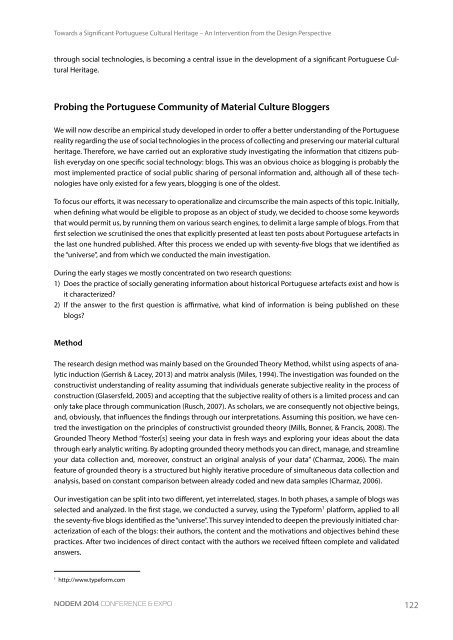NODEM 2014 Proceedings
NODEM 2014 Proceedings
NODEM 2014 Proceedings
Create successful ePaper yourself
Turn your PDF publications into a flip-book with our unique Google optimized e-Paper software.
Towards a Significant Portuguese Cultural Heritage – An Intervention from the Design Perspective<br />
through social technologies, is becoming a central issue in the development of a significant Portuguese Cultural<br />
Heritage.<br />
Probing the Portuguese Community of Material Culture Bloggers<br />
We will now describe an empirical study developed in order to offer a better understanding of the Portuguese<br />
reality regarding the use of social technologies in the process of collecting and preserving our material cultural<br />
heritage. Therefore, we have carried out an explorative study investigating the information that citizens publish<br />
everyday on one specific social technology: blogs. This was an obvious choice as blogging is probably the<br />
most implemented practice of social public sharing of personal information and, although all of these technologies<br />
have only existed for a few years, blogging is one of the oldest.<br />
To focus our efforts, it was necessary to operationalize and circumscribe the main aspects of this topic. Initially,<br />
when defining what would be eligible to propose as an object of study, we decided to choose some keywords<br />
that would permit us, by running them on various search engines, to delimit a large sample of blogs. From that<br />
first selection we scrutinised the ones that explicitly presented at least ten posts about Portuguese artefacts in<br />
the last one hundred published. After this process we ended up with seventy-five blogs that we identified as<br />
the “universe”, and from which we conducted the main investigation.<br />
During the early stages we mostly concentrated on two research questions:<br />
1) Does the practice of socially generating information about historical Portuguese artefacts exist and how is<br />
it characterized?<br />
2) If the answer to the first question is affirmative, what kind of information is being published on these<br />
blogs?<br />
Method<br />
The research design method was mainly based on the Grounded Theory Method, whilst using aspects of analytic<br />
induction (Gerrish & Lacey, 2013) and matrix analysis (Miles, 1994). The investigation was founded on the<br />
constructivist understanding of reality assuming that individuals generate subjective reality in the process of<br />
construction (Glasersfeld, 2005) and accepting that the subjective reality of others is a limited process and can<br />
only take place through communication (Rusch, 2007). As scholars, we are consequently not objective beings,<br />
and, obviously, that influences the findings through our interpretations. Assuming this position, we have centred<br />
the investigation on the principles of constructivist grounded theory (Mills, Bonner, & Francis, 2008). The<br />
Grounded Theory Method “foster[s] seeing your data in fresh ways and exploring your ideas about the data<br />
through early analytic writing. By adopting grounded theory methods you can direct, manage, and streamline<br />
your data collection and, moreover, construct an original analysis of your data” (Charmaz, 2006). The main<br />
feature of grounded theory is a structured but highly iterative procedure of simultaneous data collection and<br />
analysis, based on constant comparison between already coded and new data samples (Charmaz, 2006).<br />
Our investigation can be split into two different, yet interrelated, stages. In both phases, a sample of blogs was<br />
selected and analyzed. In the first stage, we conducted a survey, using the Typeform 1 platform, applied to all<br />
the seventy-five blogs identified as the “universe”. This survey intended to deepen the previously initiated characterization<br />
of each of the blogs: their authors, the content and the motivations and objectives behind these<br />
practices. After two incidences of direct contact with the authors we received fifteen complete and validated<br />
answers.<br />
1<br />
http://www.typeform.com<br />
<strong>NODEM</strong> <strong>2014</strong> Conference & Expo<br />
122


